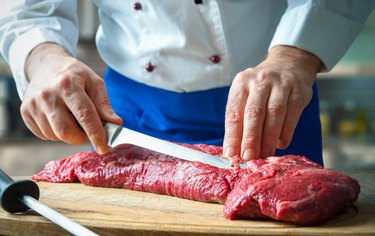
Before preparing a steak or another beef product, it is important to first check that your meat is fresh. While many grocers will include a date on the packaging indicating the latest date when you should enjoy the meat, this may not be available if you get your beef directly from a butcher or if you froze the meat to keep it fresh longer. There are a few things you can check for to ensure your beef is still fresh and safe to enjoy.
Check the Date
Video of the Day
If the packaging has a date, you can use this as a guideline to determine whether or not the beef is fresh. Keep in mind that a date does not necessarily mean that the meat has gone bad. Check the fine print on the label. Some stores will mark beef with a "sell-by" date, while others will print a "best if used by" date. If you buy fresh beef, the label may have the date the beef was purchased.
Video of the Day
These dates are not foolproof since the way that beef is stored can affect how long it will stay fresh. For example, beef wrapped in vacuum-sealed packaging will generally last longer than beef wrapped in material that allows air to contact the beef. In addition, beef stored in the refrigerator will spoil faster than frozen beef.
Bad Beef Color and Texture
Check the color and texture of the beef to help determine its freshness. When the blood in the meat is exposed to the oxygen in the air, it turns bright red. So, while fresh, vacuum-packed beef may have a purple or burgundy color, unwrapped beef will be bright red.
As the meat is exposed to the air, it oxidizes and turns brown. This usually takes approximately five days in the refrigerator. Spoiled beef may have a green or yellow coloring. Brown coloring is a sign that beef is a bit older, but it doesn't necessarily mean it is spoiled, so consider other factors, including the texture and smell of the beef.
When beef goes bad, the texture will also change. Steak dries out, and rather than being juicy, it feels tacky or slimy when you touch it. It may also have a shiny film covering the meat. Ground beef changes texture when bacteria become overgrown. Fresh ground beef has a firm, springy texture, while spoiled meat crumbles when handled.
Bad Beef Smell
Smell is another indicator that your beef has gone bad. Raw beef typically has a mild, neutral aroma and may smell of iron. If the odor is strong, sour or rotten, it is a sure sign that the beef is going bad. Spoiled steak may have an ammonialike odor. Keep in mind that some bacteria, such as salmonella and E.coli, may not cause an odor in spoiled ground beef.
Be sure to consider all of these factors when determining whether the beef is fresh or spoiled. In general, you should consume steak from the refrigerator within three to five days. If you are uncertain whether the beef is fresh, the safest option is to toss it and avoid the risk of foodborne illness.